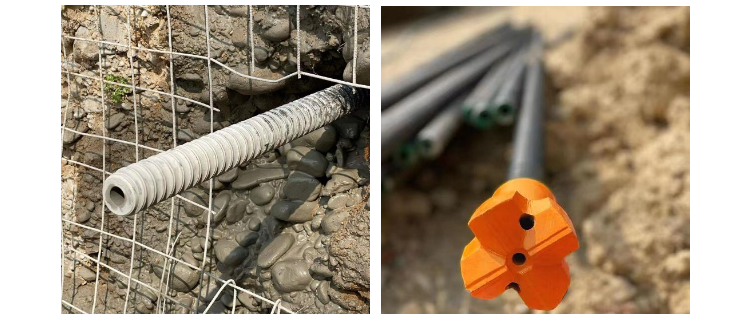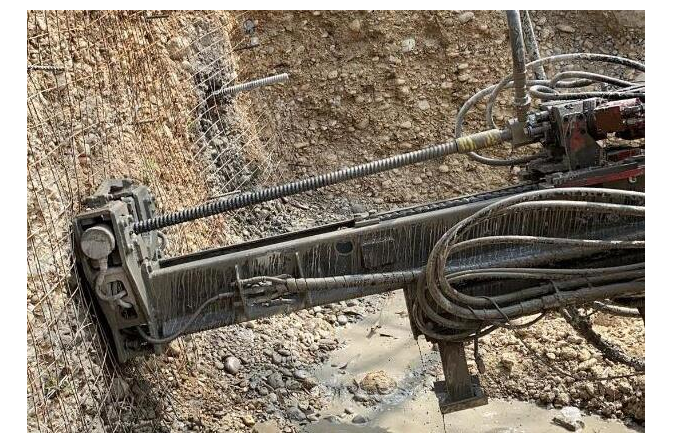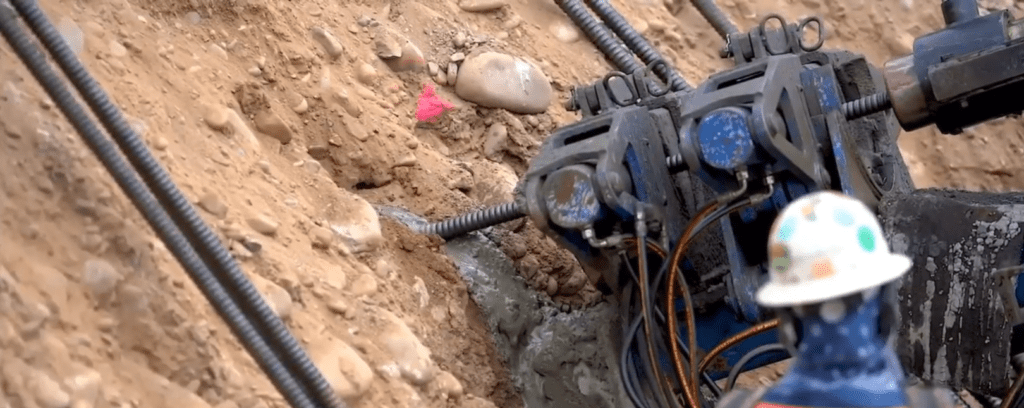Anchor support technology is a significant development and breakthrough in the field of tunnel support, playing a crucial role in addressing tunnel support challenges. However, as mining depths increase, mining projects face increasingly complex geological conditions, leading to a multitude of new issues in tunnel support. In soft and highly stressed surrounding rock conditions, limitations in construction techniques often result in the early failure of tunnel floors, ultimately leading to support failures. Therefore, tunnel support under soft and highly stressed conditions has long been a persistent challenge in mining engineering.
The self-drilling anchor system as an effective means of support has been widely applied in tunneling for advance support, radial support, slope reinforcement, roadbed reinforcement, riverbank reinforcement, arch foot reinforcement, and tunnel disaster remediation projects. In underground mines, self-drilling anchor technology serves as a rapid, convenient, and practical support technique, playing a crucial role in controlling surrounding rock deformation, improving tunnel support, and guiding production practices.
The structure and characteristics of self-drilling anchor drilling tools
1. The structure of Self-drilling anchor system
The self-drilling anchor drilling tool, as shown in the diagram below, consists of four main components: anchor bit, anchor bolt, fastening device (anchor plate, anchor nut), and coupling sleeve. The anchor bit is primarily responsible for drilling, while the anchor bolt serves three purposes:


1) acting as a drill rod during drilling
2) providing support as an anchor bolt during anchoring
3) serving as a hollow channel for grouting during injection.
2. The characteristics of self-drilling anchor drilling tools
1) It can be extended according to the drilling depth.
It has the characteristic of lengthening while drilling, making it suitable for narrow construction environments. It can achieve the function of reinforcing surrounding rock with extra-long anchor rods.


2) Self-anchoring.
The anchor rod does not need to be removed after drilling. The entire anchoring system can be tightened using its own accessories. By grouting, full-length anchoring can be achieved, evenly transferring the stress of deep surrounding rock to the surrounding rock wall, achieving mutual support between the rock and the anchor rod.


3) Self-drilling.
The self-drilling anchor rod has a continuous R or T thread, replacing the drill rod. With the anchoring drill bit, it can penetrate various types of rocks and complete drilling and anchoring.


4) Active support.
By installing the entire self-drilling anchor system, active support is formed against the surrounding rock.
5) Grouting capability.
Through the hollow anchor bolt, grouting can be carried out to reinforce the surrounding rock and fix fractured rock masses. This allows for the formation of anchor holes and ensures anchoring and grouting effects without the need for special measures such as casing or pre-grouting in various rock conditions.
6) Integration of “drilling, anchoring, and grouting”.
The self-drilling anchor system combines the functions of drilling, anchoring, and grouting, realizing composite support.


7) Flexible support.
The self-drilling anchor bolt is made of thick-walled seamless steel tube with full thread forming process, providing good extension performance. It overcomes the low extensibility of conventional anchor rods and fully utilizes flexibility to support and enhance the self-supporting capacity of high-stress surrounding rock.
Comparative Testing of Self-Drilling Anchoring Products and Conventional Anchoring Products for Support
The test site is a tunnel with a depth of 700 meters, consisting of fine-grained gray-white sandstone. The tunnel has a shape of a straight wall with a semi-circular arch, with dimensions of 4.6 meters in width and 3.6 meters in height. Four different types of anchoring support were compared in the tunnel.(The images are sourced from the internet)
1. Support Design
1) Anchor net and shotcrete support: Use grade-equivalent anchor bars, 2.4 meters in length, with a diameter of 20 millimeters. The anchor bar spacing and layout are 800mm x 800mm. The anchor cable spacing is 1.2 meters (5 cables per row) with row spacing of 1.6 meters. The anchor cable length is 7 meters, with a diameter of 15.24mm, positioned in the arch. A 100mm thick shotcrete layer is applied on the top and sides, with a 6mm diameter, 100mm mesh metal net embedded in the shotcrete.


2) Conventional support system: U36 steel supports are used with a spacing of 800mm. A 1100mm x 200mm x 60mm concrete backing plate is installed between the supports and the tunnel wall.


3) Special support system (for high-pressure tunnel support): U36 steel supports are used, in the form of fully enclosed integral supports, with a spacing of 800mm. A 6mm diameter, 100mm mesh metal net is installed between the supports and the surrounding rock. Shotcrete with a thickness of 50mm is applied on the top and sides.


4) Self-drilling anchor system support: Use self-drilling anchors with a diameter of 28mm. The anchor bar spacing is 1.0 meter (5 bars per row) with a row spacing of 1.6 meters. The self-drilling anchor system is used for support, forming a stable support structure.”


2. Test result
1) Anchor net and shotcrete support: After 6-8 months of support, localized concrete cracking occurs. After 15 months, 80% of the tunnel’s top experiences severe cracking. After 18 months, the tunnel requires secondary reinforcement support.
2) Conventional support system: After 4 months of support, localized deformations in the supports occur. After 6 months, the tunnel requires bottom plate repairs. After 15 months, the supports converge by 800mm-1400mm, and significant deformations in the supports are observed.
3) Special support system (for high-pressure tunnel support): After 10 months, slight deformations occur in localized supports, but long-term stability is maintained.
4) Self-drilling anchor system: After 12 months, slight cracking is observed in localized areas of the top, but long-term stability is maintained without the need for repairs.
3. Test Conclusion
The self-drilling anchor system, compared to traditional anchoring support systems, offers several advantages in support engineering under similar geological conditions. It provides convenience, efficiency, simplicity in operation, active support, and is suitable for narrow construction spaces, while delivering good economic benefits.
In summary, the self-drilling anchor system is a new high-tech support product with multiple functions such as drilling, grouting, and anchoring. The flexible length of the anchor bolt allows for easy extension, and the anchor bolt itself serves as both a drill rod and grouting pipe. Prior to grouting, it can function as a dust-blowing pipe to remove dust generated during drilling. During grouting, the grout is injected through the hollow anchor rod and sprayed from the drill head, filling the drilled holes and geological fractures, solidifying the anchor bolt with the surrounding soil to form a reinforced cement column. It offers convenience in construction within narrow tunnel environments and provides unique effects that cannot be replaced by other anchoring materials. It can be widely applied in various engineering projects, including railways, mines, water conservancy hubs, slopes, embankments, bridge foundations, riversides, high-rise building foundations, and structural reinforcement. Furthermore, it is suitable for the treatment of geological hazards such as ground settlement, collapse, cracks, collapses, and landslides.

